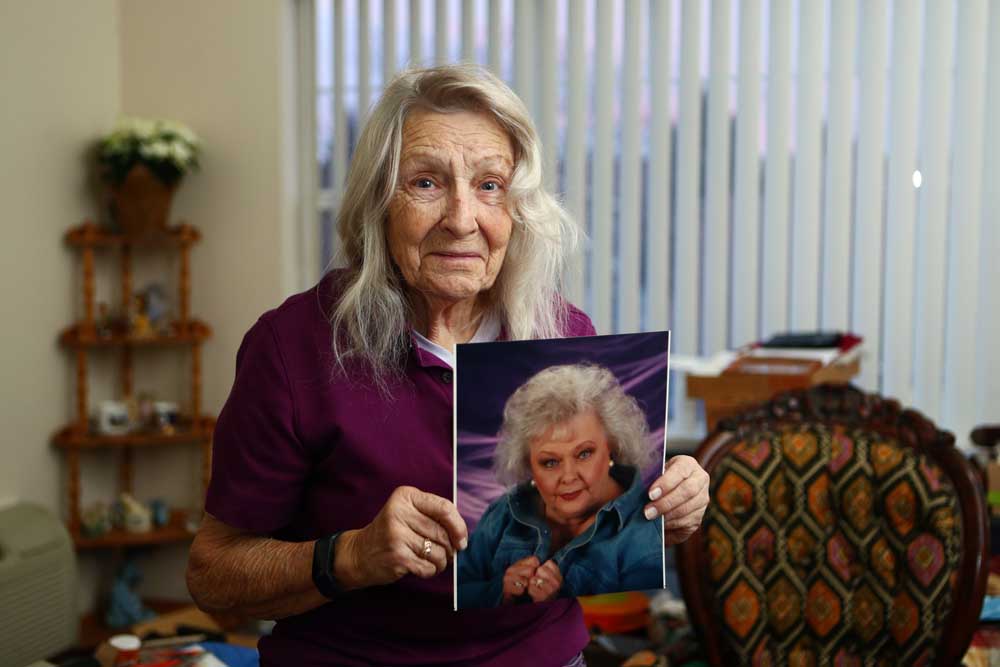From homelessness to housing: One woman’s struggle to find a home
Published 11:45 am Friday, December 22, 2023

- Jacque Lee holds a photo of her mother, Betty Moore, inside her new apartment in Bend on Dec. 14. Lee moved into the new apartment at the end of November after living in transitional housing.
Jacque Lee sat in her new living room with boxes strewn around her. She was somewhat uncomfortable in her new two-bedroom apartment, but her dog Lacey Baby strutted around with a possessive confidence.
This is home. Permanent housing. The whole idea gave her pause.
“It was scary,” Lee said. “I have lost so much that I was afraid I would lose this.”
Late last month, Lee, 73, moved into the subsidized housing unit off 27th Street in Bend from her tiny home at Central Oregon Villages, a high-barrier homeless shelter that offers a more autonomous living model for its homeless residents. She was there for six months before being approved for permanent housing. Before then, she was living out of her pickup truck.
From a pickup truck to a home
In the city of Bend, there are about 1,000 people experiencing homelessness on any given night but only 505 shelter beds available. Although the city doesn’t track how many people move into transitional housing, it knows that 78% of the homeless individuals in Central Oregon are unsheltered, said Amy Fraley, the city’s senior program manager for homelessness solutions.
But with the help of people like Fraley and former Bend Police Chief Jim Porter, board president for Central Oregon Villages, Lee has gone from living unsheltered to permanent housing.
“What it means to me is that our model works,” said Porter about the tiny homes village. “It makes me feel good after years of working in the police department and seeing the challenges on the streets that this model is working and we’re going to be able to replicate it.”
‘Chronically homeless’
Before Lee moved into her new apartment, she was what the National Institute of Health defines as “chronically homeless.” According to the Homeless Leadership Coalition’s 2023 Point in Time Count, 18% of those experiencing homelessness in Central Oregon are chronically homeless. The term applies to people who have repeatedly lost housing and/or have experienced homelessness for at least a year. Lee has been through both.
Lee’s first experience with homelessness happened in 2018 when her rental application for a house in La Pine was revoked even though Lee had paid first month, last month and her security deposit. The reason the rental company gave Lee was that her monthly income combined with her mother’s was less than three times the $1,200 rent.
Most academic and governmental circles, including the Department of Housing and Urban Development, agree that a person should only be paying 30% of his or her income on housing regardless of the rental agency’s policies. But based on 2022 census data, renters are consistently paying more than that on housing.
It puts low-income families, especially seniors living off Social Security insurance like Lee, in a difficult position as they search for affordable housing. It took Lee 11 months after her rental application was revoked before she finally found housing for her and her mother, Betty Moore.
“They’re getting between $800 to $1,000 of Social Security bonds (each month) which really puts them at only being able to afford an apartment or housing that costs about $300 a month … And the waiting lists for subsidized housing is up to three years,” said Nicki Merritt, the executive director of Central Oregon Villages.
Lee’s current apartment costs $261 per month for a two-bedroom, two-bathroom apartment. She lives in a building that is subsidized by the Low-Income Housing Tax Credit, which is a federal program that provides tax credits for housing developers who rent to those making less than 60% of the area’s median income.
Lee’s second experience with homelessness happened in 2021. At the time, she was living with her mother and two other roommates in a house in La Pine. The mother-daughter pair had settled into a new normal despite the pandemic.
Then Moore’s health took a turn for the worse. Friends and family rushed to Moore’s bedside, both to say goodbye and to reassure Lee that everything would be all right. It wasn’t. After her mother died, Lee’s two roommates insisted she continue to pay both her and her mother’s share of the rent.
“I was out picking up bottles and anything I could to try and keep my bills paid,” Lee said. “I don’t want to badmouth them as they’ll have to answer for what they did, (but) I don’t want to live with nobody now, even my kids.”
Making a place a home
Lee choked back tears as she talked about her goals for the new apartment. Right now, she just wants to get through all the boxes and get settled.
“I was going through my boxes and I found this ring from mom,” Lee said, displaying a gold ring. “It’s a little big on me, but it’s hers.”
Although Lee has officially found permanent housing, the struggle isn’t over. Her biggest challenge at the moment is finding a way to pay for the extra security deposit East Lake Villages requires for Lacey Baby.
“The doctors no longer give companionship letters, so I gotta pay for a deposit that I don’t think I have and I don’t want to lose my apartment,” Lee said. “So I have to come up with $300. I can’t get rid of her. I’ll move first.”






